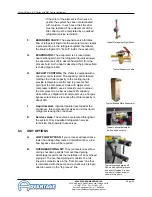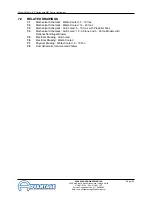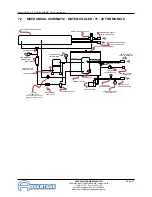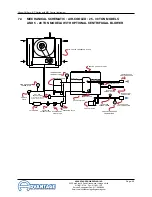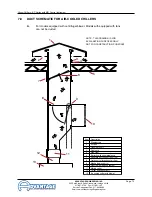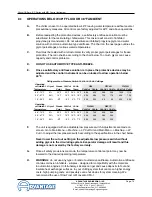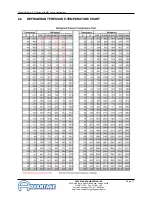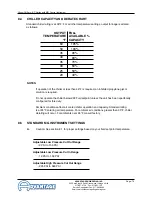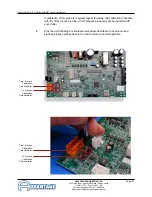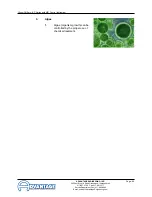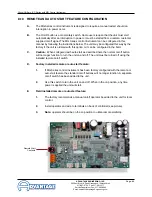
Glycol Chillers : BC Series with MG Control Instrument
Page: 76
ADVANTAGE ENGINEERING, INC.
525 East Stop 18 Road Greenwood, Indiana 46142
317-887-0729 Fax: 317-881-1277
Service Department Fax: 317-885-8683
Email: [email protected]
8.1 OPERATIONS BELOW 48°F FLUID OR 38°F AMBIENT
A.
The chiller is never to be operated below 48°F leaving water temperature without several
precautionary measures. All controls are factory adjusted for 48°F and above operations.
B.
Before readjusting the protective devices, a satisfactory antifreeze solution must be
substituted for the recirculating chilled water. This mixture will consist of inhibited
propylene glycol and water. Do not substitute an inhibited propylene glycol and water
solution with common automotive type antifreeze. The chart on the next page outlines the
glycol percentages at various water temperatures.
C.
Fluid must be tested with a refractometer to verify proper glycol percentages for freeze
protection. The ratio shall be according to the chart below. Too much glycol can cause
capacity and control problems.
D.
DO NOT USE AUTOMOTIVE TYPE ANTI-FREEZE.
E.
Once a satisfactory antifreeze solution is in place the protective devices may be
adjusted and the control instrument can be unlocked to allow operation below
48°F.
F.
The unit is equipped with an adjustable low pressure switch. Adjustments are made on
screen. Go to Main Menu -> Machine -> LP Cut Out and Main Menu -> Machine -> LP
Cut In to adjust the low pressure switch according to the specifications in the chart below.
Never lower the cut out setting on the adjustable low pressure switch without
adding glycol to the circulating system. Evaporator damage will result and this
damage is not covered by the factory warranty.
G.
Once all safety provisions are made, the temperature control set point may now be
lowered to the desired operating temperature.
H.
WARNING: do not use any type or brand of automotive antifreeze. Automotive antifreeze
contains corrosion inhibitors - silicates - designed for compatibility with the materials
in automotive engines. Unfortunately, silicates can gel and cause deposits to foul and
insulate heat exchanger surfaces. In your chilling system that can mean higher energy
costs, high pumping costs, and possibly even shut downs for system cleaning. We
recommend the use of DowFrost or Monsanto DFS-1.
Operating
or Ambient
Temperature
48° - 70°F
25° - 47°F
10° - 24°F
Glycol
0%
30%
40%
Freeze
Point
32°F
10°F
-5°F
Cut Out
Temp
32°F
10°F
-5°F
Cut In
Temp
36°F - 39°F
15°F - 18°F
0°F - 7°F
Cut-Out
58#
33#
20#
Cut-In
63#
38#
25#
Refrigerant
R22
R134A
R407C
R410A
R404A
Air-Cooled
380#
260#
405#
610#
405#
Water-Cooled
360#
260#
360#
550#
360#
R22
Cut-Out
28#
12#
4#
Cut-In
33#
17#
9#
R134A
Cut-Out
102#
63#
43#
Cut-In
111#
72#
52#
R410A
Operating
or Ambient
Temperature
48° - 70°F
25° - 47°F
10° - 24°F
Glycol
0%
30%
40%
Freeze
Point
32°F
10°F
-5°F
Cut Out
Temp
32°F
10°F
-5°F
Cut In
Temp
36°F - 39°F
15°F - 18°F
0°F - 7°F
Cut-Out
72#
44#
29#
Cut-In
79#
49#
34#
R404A
Cut-Out
52#
28#
16#
Cut-In
58#
34#
22#
R407C
Refrigerant Low Pressure Switch Cut-Out & Cut-In Settings
High Pressure Cut Out (maximum)


